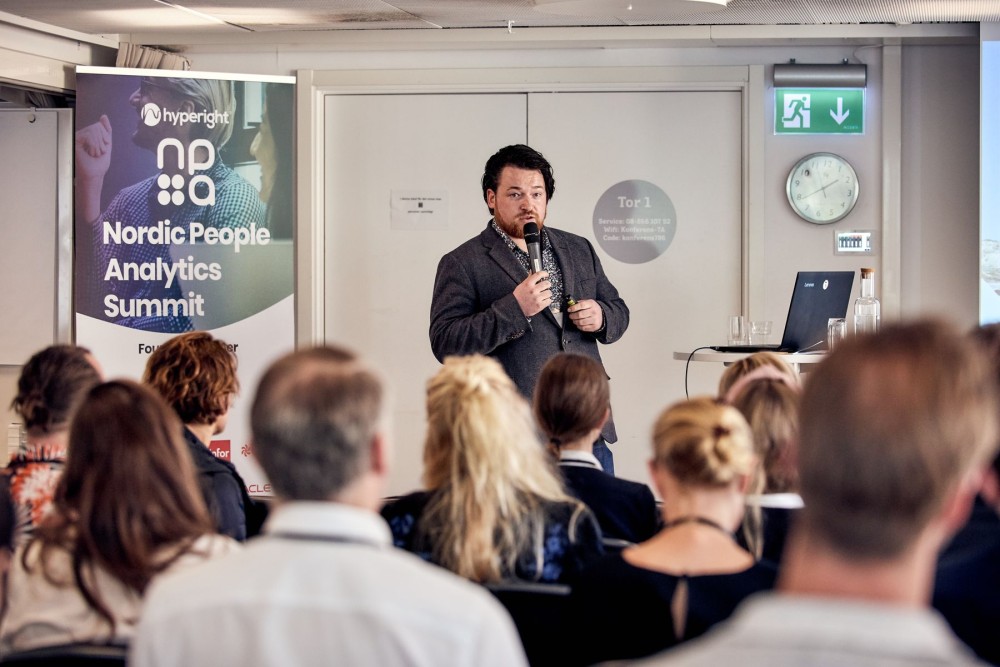Every business in the world experiences employee turnover. But although it’s normal and that’s how the labour market functions, employee it’s not the most pleasant thing for companies because it costs time and money to find replacements.
Due to this reason, employee churn and employee turnover are one of the core metrics for HR departments. Organisations are heavily investing in HR and people analytics programmes that help them figure out what’s causing their high employee turnover and what they can do to stabilise it. And many solutions have sprung up on the market, but all boils down to: Are your employees happy with their current employment and do they want to leave?
Talking about efficient people analytics solutions that have given real results, we come to Luke Whelan, Head of Analytics at Talivest. Luke gave a talk at the Nordic People Analytics Summit in Stockholm last year on a machine learning solution he built that helped a call centre to reduce its employee turnover by 30% within six months. And this is his story of how it happened.


Reducing employee turnover starts with creating culture fit for the talent
You’ve probably heard the expression “Hire for culture fit, train for skill”, which basically means hiring candidates based on their ability to conform and adapt to the core values and behaviours of an organisation. And it was culture fit that led Luke to the opportunity of creating an ML model that would drive a business impact.
Before joining Talivest, Luke worked as an Analytics Lead at LinkedIn – the go-to platform for professional networking that provides equal economic opportunities for every employee in the global workforce. Luke was so captivated by Talivest’s mission that he decided to leave the biggest professional networking platform and join a small company with a big vision: Create the best culture fit for your top talent in every company so they can retain the best people. This mission statement struck a chord with Luke, and he’s been riding with Talivest ever since.


The ML product that reduced employee turnover by 30%
The Amy ML model that Luke created helps companies create a better culture fit for their talent and ultimately reduce their turnover.
The dashboard can be adapted to different company metrics. One of the most commonly referred to metric is the NPS (Net Promoter Score) metric across the employee lifecycle: pre-hire, onboarding, stay (current employees) and exit.
We must remember that the solution resulted in a 30% decrease in employee turnover in a call centre which is a work environment with usually a very aggressive employee turnover rate.
Luke managed to achieve it by creating a risk profile for every employee based off of different data points and things that impact them in their journey in the company. The resultant model created on these criteria is 67% accurate across their other customers.
In Luke’s presentation example, the prediction shows 200 employees with high flight risk in the next six months, presented in a dollar value which includes calculations like onboarding costs, the time for an employee to give reasonable output, bad hires, and so on.


Next, the model identifies the risk factors or reasons that are causing employees to leave using principal component analysis. The risk factors can fall under management, for example, management of time-off or communication, etc.
The model uses data taken from anonymous employee exit surveys and analyses the text by using sentiment analysis in the context. However, it takes into account other features such as onboarding type, demographics, seniority, experience level, function, department.
Ultimately, the dashboard presents a company with a number of people at risk of leaving, the cost of it and the breakdown of pain points. This way, HR departments can take over and take appropriate actions to retain talent.


Learnings from deploying Machine Learning in People Analytics
For this model, Luke uses the random forest method because there is not enough data and there are too many variables. Luke, however, states that his work so far only covers the tip of the iceberg and that there are many other methods to solve the problem.
As for the approach he took, Luke suggests “work the floor”. Majority of data scientists just stick to the data and are not going out of their way to understand the problem in reality. Working the floors gives the advantage to recognise bias in the data and problems that are not recorded in surveys.
Another issue Luke has recognised working with companies is that silos are considerably present across departments. Talking about a concrete example, Luke states that one employee can be subject to up to 5 engagement surveys in a year from 5 different departments. With this, there is no way of knowing the real reasons for employees leaving. Luke’s model takes into account every point across employees’ lifecycle and maps it to the outcome of flight risk.
When working with machine learning and random forest models in people analytics, it’s crucial to think about the outcome we are trying to understand. This consideration let Luke to also focus on the onboarding variables and their effect on employee sentiment overtime.
And lastly, exit surveys are usually emotionally polarised depending on the fact if the employee is leaving willingly or is being fired. Consequently, the data in the exit surveys carries with it overexaggerated values for the key factors that resulted in employees’ premature leaves. And when this data is sleeved over the other engagement survey data, it gives a better chance of identifying factors that are causing problems in early stages.


The impact on HR
By sleeving the exit data over the other survey data, HR departments are able to highlight individuals with pain points that are providing value to the company and offer them help. And that was the ultimate goal of the machine learning project, states Luke. Based on the insights Luke provided to his client company, they were able to take actions immediately, which resulted in a 30-40% decrease in employee turnover overtime and better engagement.
Luke hopes that he will be able to roll out this initiative to other industries apart from call centres, such as the tech industry.
Apart from the ML model for identifying employees with premature leave risk, Luke is also engaged in developing an onboarding model. This model looks into how the impact of the first contact with the company, the feeling of inclusion and diversity influences employees’ output later over time. The goal of the onboarding model is as well to guide informed decision within the HR industry.














Add comment